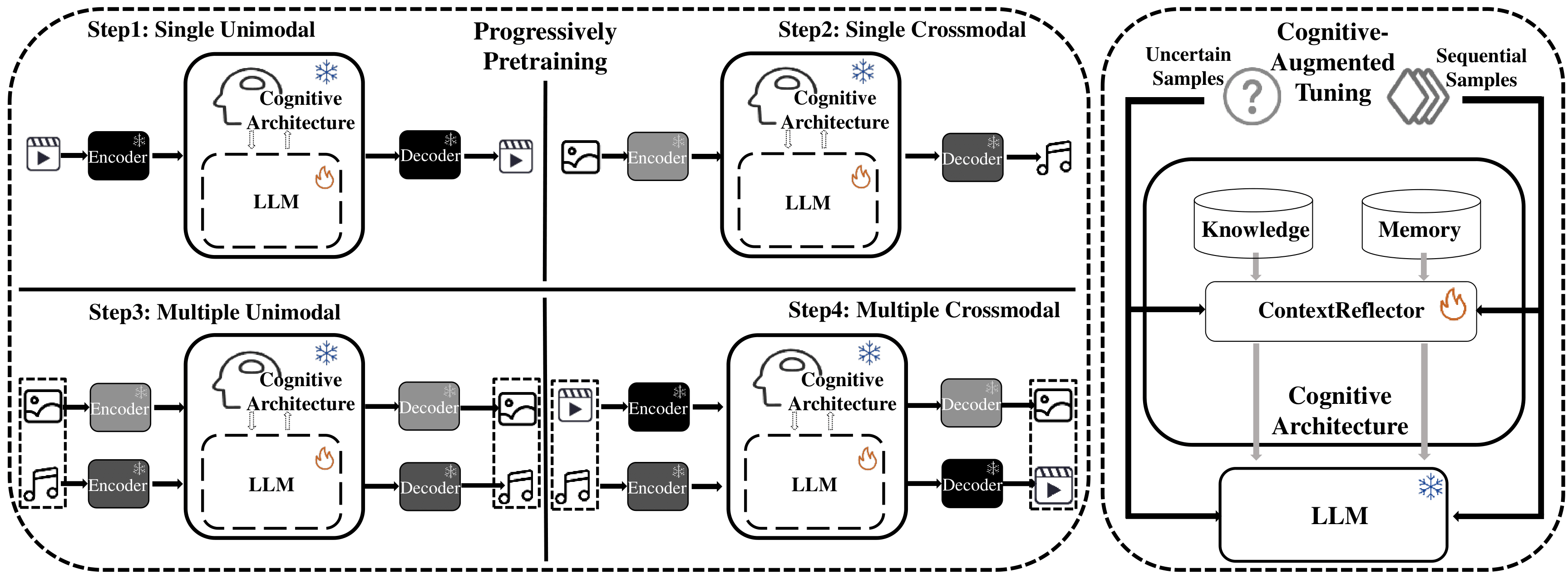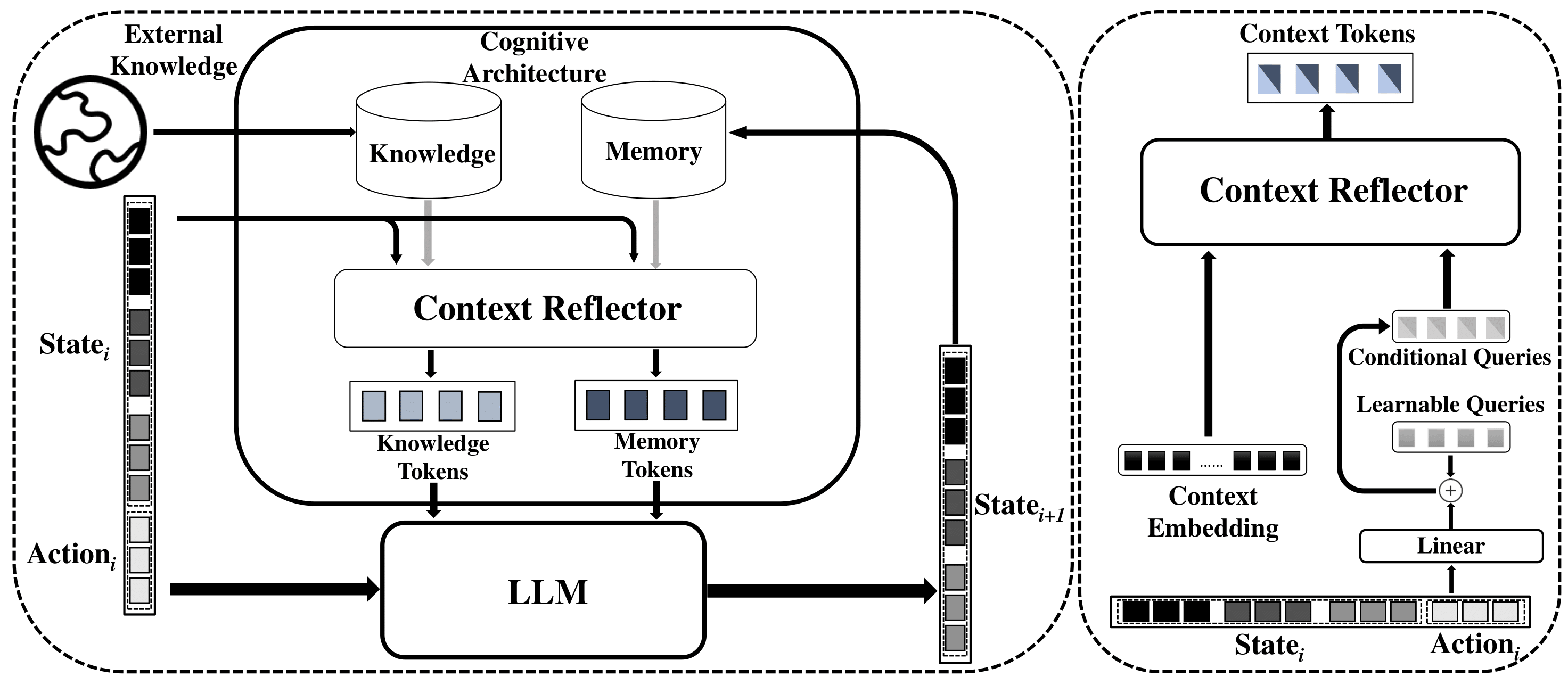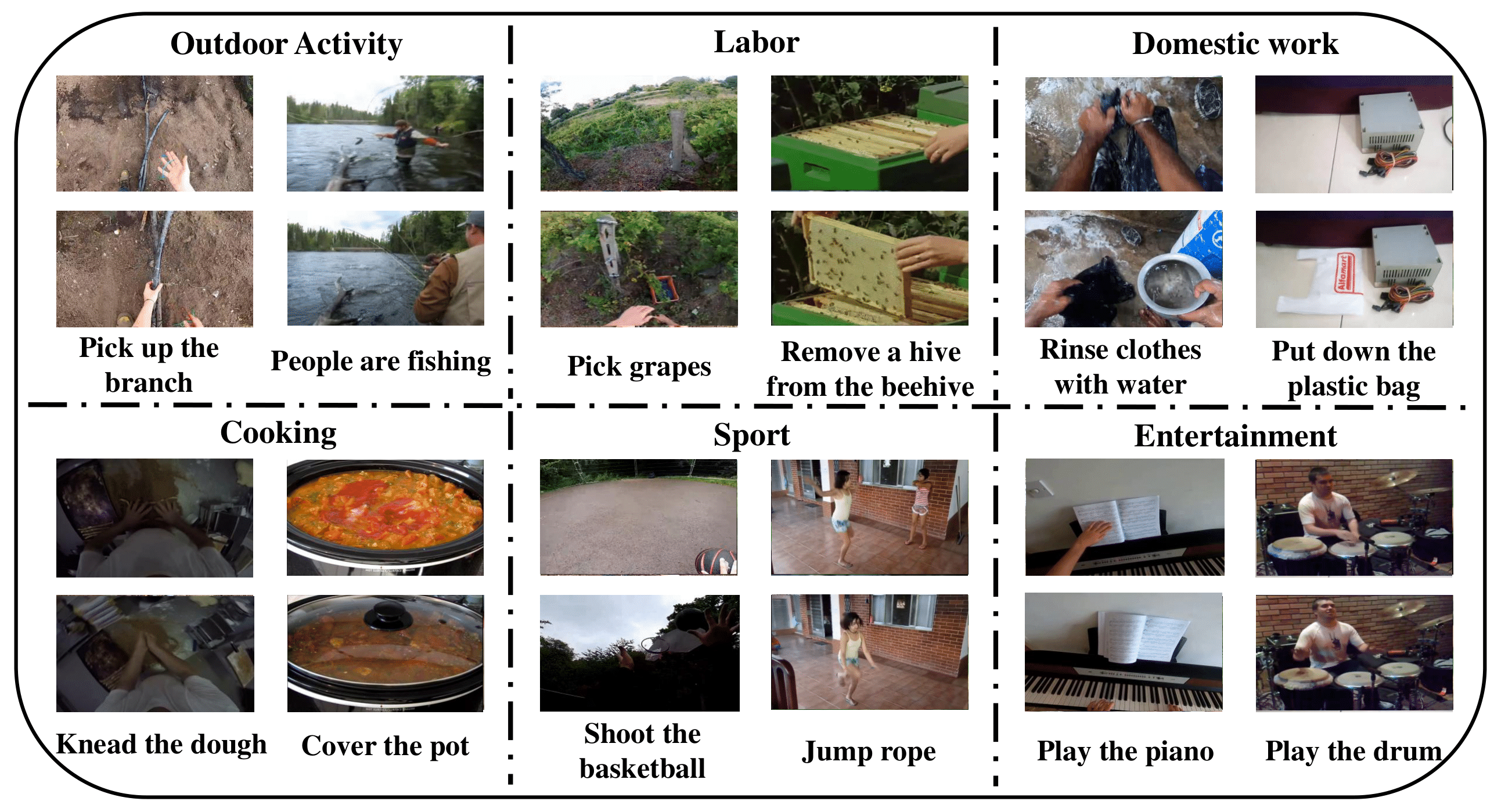Juncheng Li†, Guoming Wang, Siliang Tang, Yueting Zhuang
Zhejiang University
*Equal Contribution. †Corresponding Authors
MM 2024, Oral (Top 4%)
We propose WorldGPT, a generalist world model trained on millions of videos through a progressive state transition training process, which naturally supports input and output across any combination of modalities.
We introduce a novel cognitive architecture tailored for world models, encompassing memory offloading, knowledge retrieval, and ContextReflector. We construct high-quality sequential samples and retrieval-augmented samples to teach WorldGPT to utilize information from retrieved context through the cognitive-augmented tuning process.
We present WorldNet, a comprehensive dataset for world state transitions, ideal for training and evaluating world models.
We explore a new learning paradigm wherein multimodal agents can efficiently acquire knowledge from WorldGPT through dream tuning on synthesized data.
First clone our repository, and create a python environment via the following commands:
git clone
cd WorldGPT
conda env create -f environment.yaml
conda activate worldgpt
WorldGPT is based on following existing models. Please download the corresponding weights following the instructions:
-
Vicuna: WorldGPT employsVicuna V0 7Bas the language decoder. Prepare the full pretrained weights following the official instructions. Then, set the variable vicuna_path in the base config at Line 8. -
LanguageBindis the unified image/video/audio encoder. The model version for each modality is listed as follows:image video audio LanguageBind_Image LanguageBind_Video_V1.5_FT LanguageBind_Audio_FT The weights are automatically downloaded by default. For manual downloaded weights or customed model versions, set the variable languagebind_path in the base config at Line 13 - 16.
-
Diffusion Modelsare used to generate image/video/audio outputs (if generation is enabled). The model for each modality is listed as follows:image video audio stable-diffusion-v1-5 zeroscope_v2_576w audioldm-l-full The weights are automatically downloaded by default. For manual downloaded weights or customed model versions, set the variable decoder_path in the base config at Line 9 - 12.
Choose a pretrained checkpoint from the versions below:
| version | link |
|---|---|
| worldgpt-languagebind-image | download |
| worldgpt-languagebind-multimodal | download |
| worldgpt-decode-image | download |
| worldgpt-decode-multimodal | download |
Note that WorldGPT uses worldgpt-languagebind checkpoints by default, which output LanguageBind embeddings. Though we provide worldgpt-decode checkpoints for visualization, they do not accurately reflect the true model capabilities.
We collect state transition datasets from various source and construct a comprehensive dataset named WorldNet. WorldNet consists of two subsets: WorldNet-Wild and WorldNet-Crafted. Each dataset is further split into subsets by the data source. The available modalities of each subset are listed as follows. The WorldNet-Crafted subset can be downloaded here.
| Subset | Source | Modality |
|---|---|---|
| WorldNet-Wild | YT-Temporal-180M | image, video,audio |
| HowTo100M | image, video, audio | |
| WorldNet-Crafted | Charades | image, video, audio |
| AVQA | image, video, audio | |
| Ego4D | image, video, audio | |
| Something-Something V2 | image | |
| YouCook2 | image, video |
The downloaded dataset contains only data of original modalities. For faster training, please precompute the LanguageBind embeddings via the command:
python preprocess.py --data_root path/to/subset/modality/Train --modality image/video/audio --languagebind_path path/to/languagebind/weights
With the data prepared, organize each subset as the structure below:
└── ag/avqa/ego4d/s2s/youcook
└── image/video/audio
├── Train
└── Train_pt
In the directory of each modaltity, Train contains raw data, and Train_pt contains corresponding precomputed LanguageBind embeddings.
Finally, specify the dataset path in the training config via dataset_list variable. Here is an example:
dataset_list:
-
root: worldnet/ag # root of subset
annotaion_path: worldnet/ag/state/action_train.json # path to annotations
modality: ['image', 'video', 'audio'] # available modalities of subset
weight: 0.2 # possibility to be chosen in training
...
Additionally, set variable precomputed_languagebind to True if precomputed LanguageBind embeddings are available.
For training on custom dataset, first convert the annotas into the WorldNet format. Here is an example:
[
{
"state0": {
"video": "00001_state0.mp4",
"audio": "00001_state0.wav",
"image": "00001_state0.jpg",
"text": ""
},
"state1": {
"video": "00001_state1.mp4",
"audio": "00001_state1.wav",
"image": "00001_state1.jpg",
"text": ""
},
"action": {
"text": "adjust the mold"
},
},
...
]
Only .jpg for image, .mp4 for video, .wav for audio are valid data formats. Use an empty string to mark a missing modality. Then, you can follow the same steps as WorldNet to run on your custom dataset.
Before starting training, first check the base config, training config and deepspeed config for detailed settings.
For quick starting, run the script:
bash scripts/train.sh
Specifying the command:
deepspeed --master_addr 127.0.0.1 --master_port 28459 train.py \
--cfg_path config/train.yaml \
--save_path ckpt/worldgpt \
--load_path /path/to/worldgpt-languagebind-ckpt
Before starting inference, check the config for detailed settings, and set load_path to the worldgpt-languagebind checkpoint.
For inference with LanguageBind outputs:
import torch
import torch.nn.functional as F
from model.worldgpt import load_worldgpt_model
from model.preprocessor import PreProcessor
from dataset.utils import to
from config import load_config
if __name__ == '__main__':
_args = {'mode': 'test', 'dtype': torch.float16, 'preprocess_modality': ['video', 'audio'], 'cfg_path': 'config/test.yaml'}
args = load_config(_args)
args.update(_args)
model = load_worldgpt_model(**args)
model = model.eval().to('cuda', dtype=args['dtype'])
preprocessor = PreProcessor(args)
preprocessor.to_('cuda', dtype=args['dtype'])
video = ['demo/languagebind/skiing/video/state0.mp4', 'demo/languagebind/aircraft/video/state0.mp4']
audio = ['demo/languagebind/skiing/audio/state0.wav', 'demo/languagebind/aircraft/audio/state0.wav']
action = ['In the video, the person is skiing.', 'The aircraft starts to spray water over the forest.']
inputs, _ = preprocessor({'video': video, 'audio': audio, 'text': action})
target_modality = ['video', 'audio']
with torch.no_grad():
pred = model.generate(inputs, target_modality,
max_tgt_length=args['max_tgt_length'], top_p=args['top_p'],
temperature=args['temperature'])
to(pred, 'cpu', dtype=torch.float)
video_targets = ['demo/languagebind/skiing/video/state1.mp4', 'demo/languagebind/aircraft/video/state1.mp4']
audio_targets = ['demo/languagebind/skiing/audio/state1.wav', 'demo/languagebind/aircraft/audio/state1.wav']
targets, _ = preprocessor({'video': video_targets, 'audio': audio_targets})
for m in pred:
targets[m] = targets[m].to('cpu', dtype=torch.float)
print(m, F.cosine_similarity(pred[m], targets[m], dim=1))Alternatively, use precomputed LanguageBind embeddings inputs:
import torch
import torch.nn.functional as F
from model.worldgpt import load_worldgpt_model
from dataset.utils import to
from config import load_config
if __name__ == '__main__':
_args = {'mode': 'test', 'dtype': torch.float16, 'cfg_path': 'config/test.yaml'}
args = load_config(_args)
args.update(_args)
model = load_worldgpt_model(**args)
model = model.eval().to('cuda', dtype=args['dtype'])
video = ['demo/languagebind/skiing/video/state0.pt', 'demo/languagebind/aircraft/video/state0.pt']
audio = ['demo/languagebind/skiing/audio/state0.pt', 'demo/languagebind/aircraft/audio/state0.pt']
action = ['In the video, the person is skiing.', 'The aircraft starts to spray water over the forest.']
target_modality = ['video', 'audio']
video = torch.stack([torch.load(p) for p in video]).to('cuda', dtype=args['dtype'])
audio = torch.stack([torch.load(p) for p in audio]).to('cuda', dtype=args['dtype'])
inputs = {'video': video, 'audio': audio, 'text': action}
with torch.no_grad():
pred = model.generate(inputs, target_modality,
max_tgt_length=args['max_tgt_length'], top_p=args['top_p'],
temperature=args['temperature'])
to(pred, 'cpu', dtype=torch.float)
video_targets = ['demo/languagebind/skiing/video/state1.pt', 'demo/languagebind/aircraft/video/state1.pt']
audio_targets = ['demo/languagebind/skiing/audio/state1.pt', 'demo/languagebind/aircraft/audio/state1.pt']
video_targets = torch.stack([torch.load(p) for p in video_targets])
audio_targets = torch.stack([torch.load(p) for p in audio_targets])
targets = {'video': video_targets, 'audio': audio_targets}
for m in pred:
print(m, F.cosine_similarity(pred[m], targets[m], dim=1))We also provide a script for batch inference. First prepare your input data following instructions in Prepare Datasets, and specify the dataset and input/target modalities in the config. Then run the command to start inference:
python batch_inference.py
We provide the worldgpt-decode checkpoints for visualized inference. See visualized_inference.ipynb for details.
If you found this work useful, please consider giving this repository a star and citing our paper as followed:
@misc{ge2024worldgpt,
title={WorldGPT: Empowering LLM as Multimodal World Model},
author={Zhiqi Ge and Hongzhe Huang and Mingze Zhou and Juncheng Li and Guoming Wang and Siliang Tang and Yueting Zhuang},
year={2024},
eprint={2404.18202},
archivePrefix={arXiv},
primaryClass={cs.AI}
}Our project is developed based on the following repositories:
-
NExT-GPT: Any-to-Any Multimodal Large Language Model
-
LanguageBind: Extending Video-Language Pretraining to N-modality by Language-based Semantic Alignment
This repository is under BSD 3-Clause License.
If you have any question about our work, please feel free to contact Hongzhe Huang and Zhiqi Ge.




